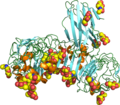Damage-associated molecular patterns (DAMPs) are molecules within cells that are a component of the innate immune response released from damaged or dying...
36 KB (3,641 words) - 12:47, 1 October 2024
signalling proteins to stimulate an immune response, the damage-associated molecular pattern (DAMP) model theorizes that the immune system responds to...
11 KB (1,153 words) - 15:53, 1 September 2024
Pathogen-associated molecular patterns (PAMPs) are small molecular motifs conserved within a class of microbes, but not present in the host. They are...
13 KB (1,476 words) - 12:50, 13 January 2024
can be sensed by the immunity as damage-associated molecular patterns (DAMPs). They are able to interact with pattern recognition receptors like TLR2 or...
49 KB (5,533 words) - 08:12, 2 November 2024
molecules: pathogen-associated molecular patterns (PAMPs), which are associated with microbial pathogens, and damage-associated molecular patterns (DAMPs), which...
43 KB (5,173 words) - 21:02, 10 August 2024
membrane rupture and release of cytokines, as well as various damage-associated molecular pattern (DAMP) molecules such as HMGB-1, ATP and DNA, out of the...
35 KB (3,948 words) - 06:00, 10 June 2024
innate immune system response and his development of the damage-associated molecular pattern (DAMP) model of immune response initiation in collaboration...
10 KB (1,233 words) - 20:14, 7 February 2024
example, S100A1, S100A2, S100A3. They are also considered as damage-associated molecular pattern molecules (DAMPs), and knockdown of aryl hydrocarbon receptor...
12 KB (1,164 words) - 20:59, 17 January 2024
hydrophobic regions on biological compounds as among the damage-associated molecular patterns (DAMPs) of the danger model. Facing stressors, cells misfold...
21 KB (2,283 words) - 23:22, 4 October 2024
Management Program, a software for managing disk storage array Damage-associated molecular pattern, a part of the immune system Damp (structural), the presence...
1 KB (196 words) - 15:33, 9 August 2023
immune modulator and endogenous opponent of proinflammatory damage associated molecular pattern molecules. It is speculated this interaction may be through...
22 KB (2,660 words) - 15:08, 13 July 2024
of pathogen-associated molecular patterns (PAMPs) that enter the cell via phagocytosis or pores, and damage-associated molecular patterns (DAMPs) that...
14 KB (1,532 words) - 23:00, 21 November 2023
epithelial barrier may also release alarmins (a type of damage associated molecular pattern (DAMP) molecule) such as thymic stromal lymphopoietin, IL-25...
54 KB (5,811 words) - 13:08, 9 November 2024
Cellular NAD+ levels have been shown to decrease with age. Damage-associated molecular patterns (DAMPs) are molecules that are released during cell stress...
20 KB (2,350 words) - 02:42, 26 September 2024
A, Polo SE (June 2016). "Epigenome Maintenance in Response to DNA Damage". Molecular Cell. 62 (5): 712–727. doi:10.1016/j.molcel.2016.04.006. PMC 5476208...
156 KB (15,400 words) - 03:45, 20 November 2024
DORN1 (section Molecular properties)
inflammatory responses in green plants, with ATP acting as a damage-associated molecular pattern molecule. In response to cell lysis, ATP is discharged and...
4 KB (386 words) - 01:40, 11 November 2023
produced by actin-myosin contraction during apoptosis release damage-associated molecular pattern proteins before secondary necrosis occurs". Cell Death and...
18 KB (1,984 words) - 22:03, 3 July 2024
R gene (section Pattern recognition receptors (PRRs))
may detect a Pathogen-Associated Molecular Pattern or PAMP (alternatively called MAMP for microbe-associated molecular pattern). The R protein encodes...
18 KB (2,099 words) - 18:35, 12 August 2024
TLR4 can also be activated by endogenous compounds called damage-associated molecular patterns (DAMPs), including high mobility group box protein 1 (HMGB1)...
75 KB (9,082 words) - 15:56, 2 November 2024
infections, as well as pathogen-associated molecular patterns, damage-associated molecular patterns, and cytokines that are released during infections,...
40 KB (3,997 words) - 08:18, 19 August 2024
infection by recognizing Pathogen Associated Molecular Patterns (PAMP) and endogenous Damage Associated Molecular Patterns (DAMP). PEPR 1 considered as the...
11 KB (1,423 words) - 11:32, 23 January 2023
Mitochondrion (section Molecular basis for tethering)
they are a source of various damage-associated molecular patterns (DAMPs). These DAMPs are often recognised by the same pattern-recognition receptors (PRRs)...
167 KB (18,357 words) - 17:01, 19 November 2024
MLKL leads to the inflammatory phenotype and release of damage-associated molecular patterns (DAMPs), which elicit immune responses. Necroptosis is specific...
14 KB (1,667 words) - 09:21, 5 November 2024
neuroimmune system is involved in reflexes associated with parasitic invasions of hosts. Nociceptors are also associated with the body's reflexes to pathogens...
28 KB (3,180 words) - 07:26, 2 April 2024
molecular patterns) or by signals connected to tissue damage named DAMP (damage associated molecular patterns). Majority of antigen presenting cells (APCs) in...
26 KB (3,352 words) - 21:47, 16 November 2024
NLRP3 inflammasome forms by binding to pattern recognition receptors (PRRs) and damage associated molecular patterns (DAMPS) that activate caspase 1 which...
26 KB (2,161 words) - 09:36, 23 July 2024
cytosolic pattern recognition receptors (PRRs) sensing microbe-derived pathogen-associated molecular patterns (PAMPs), damage-associated molecular patterns (DAMPs)...
71 KB (7,823 words) - 15:14, 12 November 2024
Lectin receptor kinases (LecRKs) are believed to recognize damage associated molecular patterns (DAMPs), which are created or released from herbivore attack...
30 KB (3,038 words) - 13:30, 24 October 2024
wounding events with damage-associated Molecular Patterns (DAMPs). Additionally, plants rely on microbe-associated molecular patterns (MAMPs) to defend themselves...
13 KB (1,802 words) - 02:06, 11 November 2023
in aging-related pathologies". Ageing Research Reviews. Damage-associated molecular patterns and their pathological relevance in ageing. 24 (Pt A): 29–39...
16 KB (1,690 words) - 17:45, 5 November 2024


















